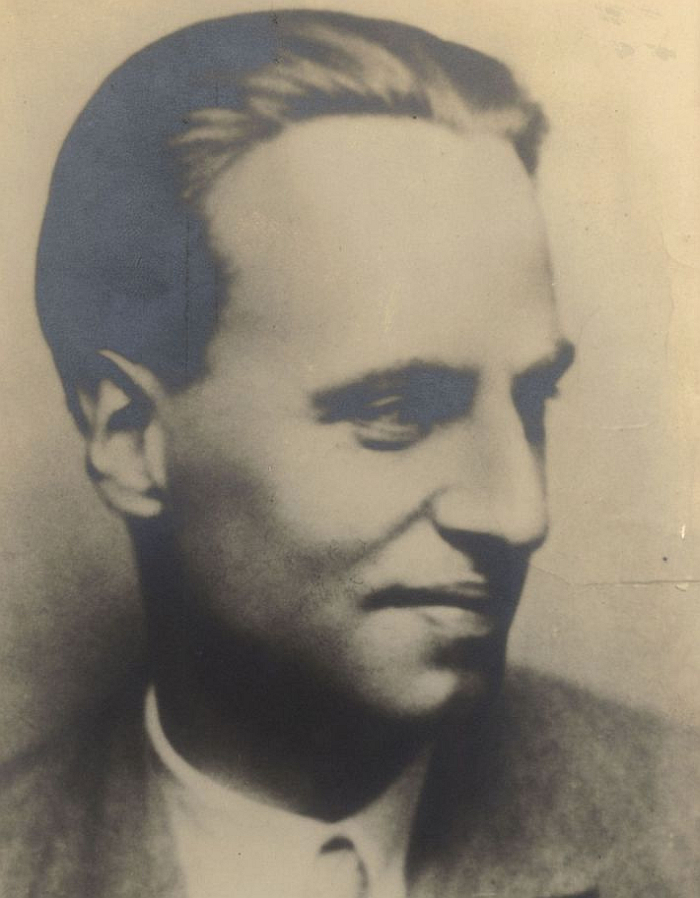smow Blog Design Calendar: September 22nd 1952 – Mart Stam suspended as Rector of the Hochschule für angewandte Kunst, Berlin
As a general rule we prefer to focus the Design Calendar on positive events, it just seems more, well, positive; however, sometimes a negative event is more illustrative of a situation, provides for better access to a story.
An event such as Mart Stam’s beurlauben, suspension, as Rector of the Hochschule für angewandte Kunst, Berlin, on September 22nd 1952.
The unhappy end of Mart Stam’s not altogether joyful sojourn in East Germany.
But also a moment that allows for some focussed considerations on both the person Mart Stam and on his understandings of art, architecture and design.
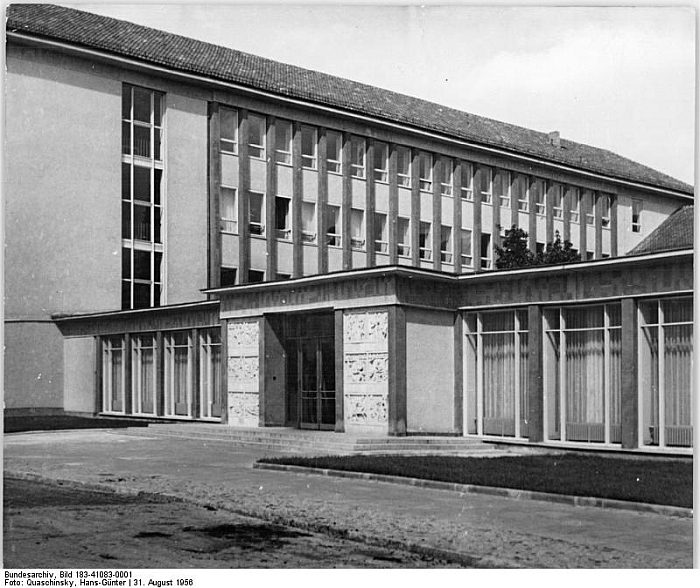
Kunsthochschule Berlin-Weißensee ca 1956, with its new extension. Thus not as Mart Stam knew it… (Photo: Hans-Günter Quaschinsky, courtesy Bundesarchiv, Bild 183-41083-0001 / CC-BY-SA 3.0 via commons.wikimedia.org)
That we have discussed the life and times of Martinus Adrianus Stam in an earlier post, we refer you there dear reader for the fuller Stam biography, and begin here in 1948 with Mart Stam’s arrival in the, then, Soviet Occupation Zone, SBZ. The future East Germany.
Or, no…. better still, let’s start in Holland, in the decade leading up to 1948.
Having spent the early 1930s in the Soviet Union contributing to the architectural component of Stalin’s first five year plan as a member of Ernst May’s Brigade, Mart Stam returned to Amsterdam in 1934 and where in 1939 he was appointed Director of the Institute for Applied Arts Education, IvKNO: today, the Rietveld Academy, then, according to the magazine De 8 et Ophouw, “an institution that in recent years visual artists have lost interest in, and which is somewhat dazed and fallen asleep.”1 Mart Stam’s task was to reawaken not only the institute, but interest in it amongst creatives of all hues.
A task hindered not only by the outbreak of war, but, according to Stef Jacobs, by a strong resistance amongst sections of the staff and students to the person Mart Stam and his somewhat authoritative, high-handed, character, and by a strong resistance amongst sections of the staff and students to his plans to re-configure the institute’s programme along more functionalist lines, of gearing the focus of the programme away from an understanding of art as an independent unicum to an understanding of art as a partner of industry.2
And a task further hindered by Mart Stam’s politics, for all his association with the Stalinist state and his long-standing reputation as a communist; a reputation and association which not only caused problems at the IvKNO but in wider Dutch society and meant that in the immediate pre- and post-War years Stam received little or no meaningful architectural commissions. Which is no good place for an architect to find themselves. And certainly not an architect such as a Mart Stam who in the previous two decades had been so closely involved with the development and dissemination of new ideas of not just architecture, construction and urban planning but of architecture, construction and urban planning’s relationships with the individual and society. And who was still fired by such.
Or put another way, post-War Amsterdam wasn’t a happy place for a Mart Stam.
And then, as Stam’s, then, wife Olga later recalled, “we .. received the invitation to Dresden. Mart Stam shone with joy, enormous impatience took hold of him – a quick departure was required and so it happened!”3
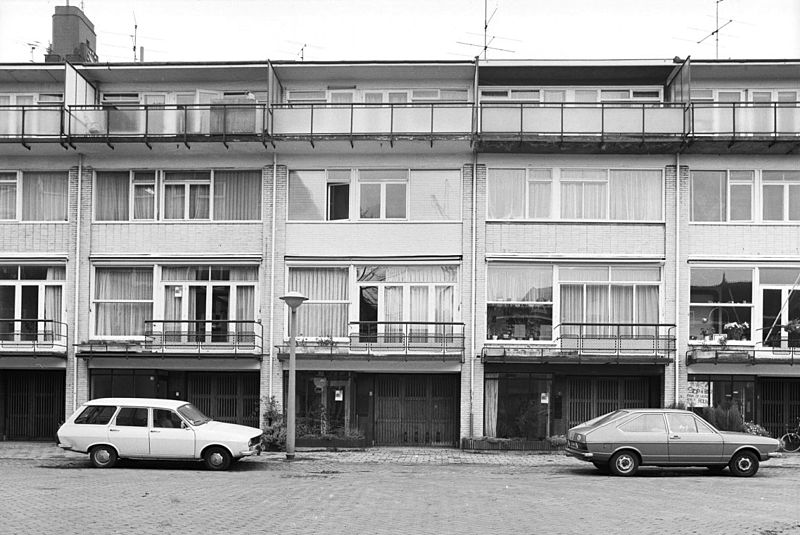
Drive-in houses in Anthonie van Dijckstraat, Amsterdam by Stam-Beese, Stam, van Tijen and Maaskant from 1936, one of the few projects realised by Stam on his return from the Soviet Union (photo courtesy Rijksdienst voor het Cultureel Erfgoed via commons.wikimedia.org)
If not that quickly.
The invitation that caused such joy and relief in the Stam household had, by all accounts, been largely driven by Liv Falkenberg4, a fellow Netherlander and who after studying interior design at the Kunstnijverheidsschool Quellinus Amsterdam and art history at Zürich University had spent time in the late-1920s as an assistant to J.J.P. Oud in Rotterdam, a period that included Oud’s participation in the 1927 Weißenhofsiedlung building exhibition in Stuttgart and thus, one presumes, Falkenberg’s participation in Oud’s participation, before in 1931 she began a carpentry training at the Deutsche Werkstätten Hellerau. An association with Hellerau she renewed post-War and which saw her cooperate with the ex-Bauhäusler Selman Selmanagić, Edmund Collein and Herbert Hirche on numerous furniture and interior design projects.
Stam and Falkenberg had first met in early 1920s Holland where both were active in the inter-War peace movement, and not only did their subsequent careers follow similar, continually inter-crossing, paths, if always in slightly different contexts; nor only were they both involved with the War time resistance in Amsterdam, although apparently unaware at the time of the other’s role; nor only did they share numerous understandings of and positions to architecture and design; but, and importantly for this story, Liv’s husband Otto Falkenberg was the post-War Industry Minister in Sachsen and thus co-responsible for organising the post-War rebuilding of eastern Germany. And co-responsible for organising Stam’s invitation to Dresden.
An invitation which according to Rainer Beck was dispatched from Dresden in April 1946. And arrived in Amsterdam in July 1946.5 A three month journey which underscores the complexities of rebuilding the European postal system in the wake of the Second World War. And an invitation which offered Stam the choice of “the Direction of the Building and Construction Department of the Technischen Hochschule [Dresden] or the Rectorship of the Akademie der Bildenden Künste [Dresden].”6
The joy and relief at the offer, the joy and relief at the opportunity to move on from his tribulations in Amsterdam, ¿the joy and relief at another opportunity to contribute to the establishment of a socialist state?, being tangible in Stam’s reply in which he states that upon receiving the letter he had instantly resigned from his post at IvKNO, and is a reply which in its tone tends to confirm that an “enormous impatience took hold of him” and his intention to move to Dresden post-haste.7
But the post, as noted above, was distinctly lacking in haste in late 1940s Europe, and not just the post. And thus on account of delays and uncertainties in the processes, competencies and administrative faculties in the SBZ, and lost and delayed letters, it took until July 1948 before Mart and Olga Stam moved to Dresden.
And where initially little appears to have happened; the Stams living with the Falkenbergs and awaiting further instruction. A state of affairs Beck implies was, at least partly, related to the fact that, “that the Ministry itself had not yet a final concept for merging the two universities”.8
The “two universities” being the Akademie der Bildenden Künste, the city’s fine art college, an institute tracing its history back to 1764, and the Werkkunstschule an institution arising from the century younger Kunstgewerbeschule, Applied Arts College; and two institutions that in the new post-War reality were to be merged into a single institution, a plan largely driven by the Dresdner artist, and Akademie alumni, Hans Grundig, who had been appointed Rector of the Akademie in April 1947, and who was motivated by a vision of a “new blossoming of the art city Dresden”9 with the newly unified institution at the vanguard. And Bruno Paul at the helm.10
However, and as Gerhard Hirche deliciously, if somewhat understatedly, phrases it, “es existierten auch Gegenkräfte“,11 “there were also opposing forces”. Opposing forces who, and reading somewhat between the lines, were seeking to develop architecture and design in the fledgling Socialist state in a, let’s say, more radical direction than a Bruno Paul, and despite all his International Modernist understandings, would have favoured, and for whom Mart Stam was the answer.
And opposing forces who prevailed: in November 1948 Mart Stam was formally appointed Professor of Architecture12 at, and Acting Rector of, the Werkkunstschule,13 before in December 1948 being appointed Acting Rector at the Akademie der Bildenden Künste. And with Stam as head of both, a de facto when not yet formal, merger of the two schools was achieved.
And so, yes, a bit of a coup d’etat. Or as Simone Hain notes, for all in context of Hans Grundig’s removal as Rector of the Akademie to make way for Stam, “a deliberate affront”,14 not least because two months earlier Grundig had signalled his acceptance of Stam and willingness to work alongside him, describing him as “probably the most important specialist” and someone who “grasps things correctly politically”15; and thus a relatively brutal approach on the part of Stam’s supporters and a development which for Hain meant that “conflicts between the “newcomer” the “cosmopolitan globetrotter” and the resident artists were clearly inevitable.”16
And so it came to pass.
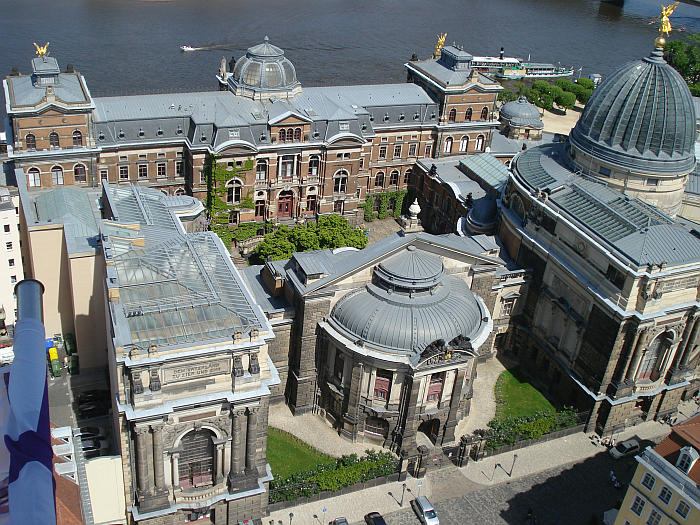
The contemporary Hochschule für Bildende Künste Dresden (Photo Kay Körner via commons.wikimedia.org CC BY 2.5)
Mart Stam’s plan for the newly unified institution foresaw, as with his plan for the IvKNO Amsterdam, not only a primacy of architecture very much in the Bauhaus mould, but of an understanding of art as a partner of industry rather than art as for the production of the one-off, the unicum.
Or as Stam formulated it in his Inaugural Address, “we understand that art should no longer be a pleasant entertainment for a few preferred connoisseurs, but that art has the task of making the life of all working people – men, women and children, deeper and richer. We understand that the task assigned to art and the artists today is broader and more comprehensive than ever before – because today we want the cultural niveau of the environment of every individual worker and working family to be raised. The few, one-off, artistic moments say little about the standard of living of a people – rather the hundreds of objects and customs of daily routine are the eloquent witnesses of the cultural niveau of a people and their time.”17
And an understanding of the role and function of art, which, understandably, brought forth the same resistance in Dresden, as it had previously in Amsterdam, from those staff and students who understood their calling as creating “one-off, artistic moments”. Who understood, and had no problem with, l’art pour l’art. And of which there, unsurprisingly, were many in the Akademie der Bildenden Künste.
And a resistance amplified in Dresden on account of Stam’s proposed reorganisation of the teaching structure and methods, and for all his introduction of a system where all students attended a number of different classes across the schools whole programme, and thereby doing away with what Stam referred to as the “backward studio principle”,18 the Akademie’s Meisterschüler structure with each Professor having their own atelier, own students, own autonomy, and thus not only a well, and long, established system of art education, but one that many artists associated with, as defining, art education.
However, by the time Mart Stam held his Inaugural Address in October 1949, and thus almost a year after taking up his appointments, his future in Dresden was already in the balance. A state of affairs tending to be underscored by the ten months it took to hold his Inaugural Address. And a state of affairs arising largely, exclusively? on account of the concentrated resistance to his plan. And for all the concentrated resistance to his plan amongst the staff and students of the Akademie, where, and amongst other protest actions, in 1949 some 49 students refused to return for the summer semester, many from Prof. Wilhelm Rudolph’s class, whom Stam had dismissed, and 54 refusing to return for the 1949/50 winter semester; numbers which reflected some 20% of the total students, and some 50% of the Akademie students19, and which not only underscores the level of discord arising from Stam’s plans, but also caused problems between Stam and the local branch of the ruling, Sozialistische Einheitspartei Deutschlands, SED.
A local SED with whom Stam, by all accounts, in any case enjoyed an anything but cordial relationship; for all a less than cordial relationship with Sachsen’s Education Minister Helmut Holtzhauer. Amongst other perceived failings Stam being accused of doing his own thing, refusing to follow orders and generally not toeing the party line; something underscored by his refusal to follow Holtzhauer’s request, demand, that he appoint Franz Ehrlich to the teaching staff20 and by his refusal to sign Lea Grundig’s contract, and thereby formally complete her appointment as the institute’s Prorector, Stam’s deputy. And that despite Holtzhauer ordering him to. Stam, with a childlike stubbornness, locking Grundig’s, unsigned, contract in his desk and refusing to release it.21
Which, surprisingly, all did little to assist Mart Stam in the realisation of his plans. A little more diplomacy may have been called for; however diplomacy wasn’t one of Mart Stam’s strengths.
Not that Mart Stam’s tenure in Dresden was only problems and discord.
Amongst Mart Stam’s first, and more successful, actions on taking up his dual rectorship was the establishment of a so-called Produktionsausschuß, Production Committee, as a platform for coordinating cooperations between the school and industry, part of the school’s contribution to raising the “cultural niveau” of the “objects and customs of daily routine” and a contribution approached through projects such as, and amongst others, the development of furniture for student flats in cooperation with the Deutsche Werkstätten Hellerau, prototypes for radios in cooperation with Sachsenwerk Dresden, and textile patterns and models for manufacturers as diverse as Möbelstoffweberei Lengefeld, VEB Gardinenwerk Dresden or Pastell VEB Limbach. While Mart Stam himself developed a wall lamp based on a design of his dating from his time in Frankfurt in the late 1920s, and which was realised in stoneware by IKA Beleuchtungskörper Dresden.22
However, Mart Stam’s tenure in Dresden was principally one of problems and discord, not all self-made, but Mart Stam unarguably contributed to the problems and discord; and thus on April 30th 1950 Mart Stam left his double position at the still not officially merged “two universities” in Dresden. And on May 1st 1950 was appointed Rector at the Hochschule für angewandte Kunst, Berlin.
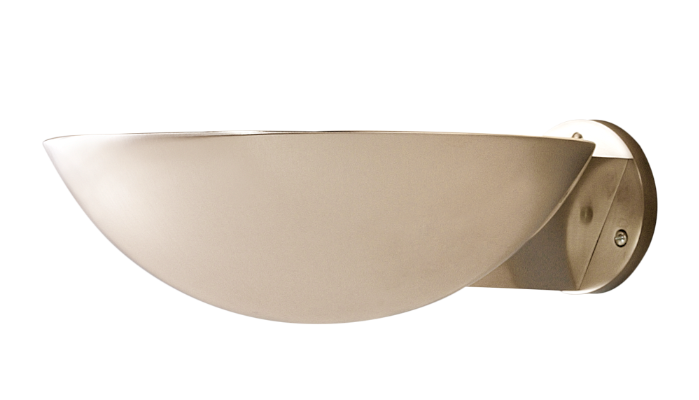
Wall lamp by Mart Stam, here as the contemporary MSW 27 through tecnolumen (photo © tecnolumen)
An institution which, as opposed to Dresden, had no history. Was a post-War creation, an institution established in 1946 largely under the initiative of the sculptor Otto Sticht, and that, as Sticht opined, with the intention “to seek out the hidden and dormant artistic talents, especially from working-class circles”,23 an institute which initially instructed in fine art, applied art and craft, which sought to unite art and craft, or perhaps more accurately, sought to train “artists who think in terms of craftsmanship”24, and that as “pioneers paving the way for a new German art and German culture in the course of a democratic renewal” and to “endeavour to apply artistic abilities where eland and thus the demands of the masses are greatest, with objects of daily use”.25 Which all posses the very obvious question, why Stam wasn’t sent to Berlin rather than Dresden in 1948?
In contrast to Dresden Mart Stam resisted his natural impulse to place architecture at the forefront, and instead focussed on the “objects and customs of daily routine”. And for all focussed on the Institut für industrielle Gestaltung, the Institute for Industrial Design.
Whereas in Dresden Stam had to establish a platform for cooperations between the school and industry, in Berlin the official authorisation and financing for such a platform already existed, but the Institute itself didn’t; thus Stam had a more or less blank canvas to work with, his initial sketches being depicted in his draft proposal from August 1950 in which he argues that the institute is “necessary and possible”: the latter “because no longer profit, but what is socially necessary and what is economically and technically possible are the basis and starting point of our production”; the former because, so Stam, the existing consumer goods failed to meet not only the possibilities of industrial production but the needs and demands of contemporary society, and that such an institute was required “to achieve a qualification of the products of mass demand through exemplary design and thus to raise the general cultural niveau”.26 To this end he recruited designers as varied as, and amongst others, Marianne Brandt, Albert Krause or Max Gebhard, and so not only Bauhäusler, but certainly designers of a modernist persuasion.
And which brings forth the inevitable comparison between the Institut für industrielle Gestaltung, and indeed Stam’s Produktionsausschuß in Dresden, and developments in the 1950s at the HfG Ulm. A comparison which allows for some very nice reflections on the differences and similarities between post-War design in Germany (West) and Germany (East), and a comparison that for reasons of space, we’ll save for another day.
Save to note that in Ulm Otl Aicher, Hans Gugelot, Max Bill et al, didn’t have to contend all too much with the inconsistencies of political ideologies, nor with preserving, resuscitating?, inventing? a (perceived) national cultural heritage….
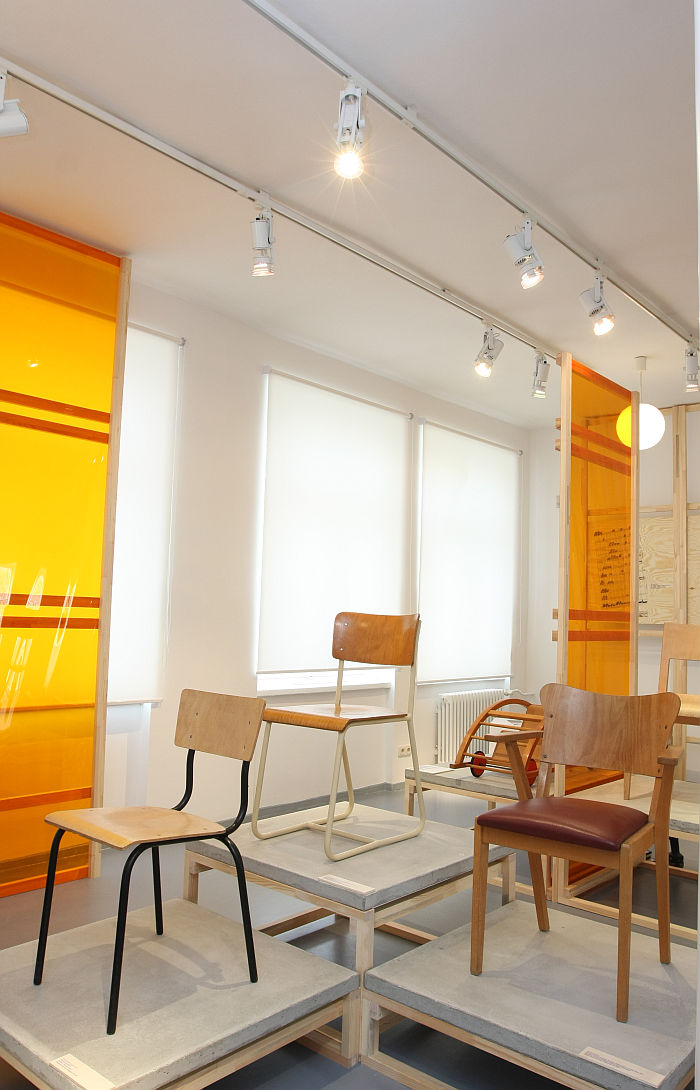
3101 chair from VEB Stima Stendal (l) Werkstattstuhl by Mart Stam for Kunsthochschule Berlin Weissensee (m) & Seminarstuhl by Selman Selmanagic, Herbert Hirche & Liv Falkenberg for Deutsche Werkstätten Hellerau (r), as seen at Shaping everyday life! Bauhaus modernism in the GDR, Dokumentationszentrum Alltagskultur der DDR, Eisenhüttenstadt
Mart Stam did.
His arrival in Berlin famously coinciding with an acceleration of the so-called Formalism Debate in the newly established DDR. A debate we’ve often discussed in these dispatches, a debate which positioned the fledgling DDR in favour of ornament, decoration and more classical formal expressions in architecture and design and against “formalism”, and thus, and simplifying dangerously, against “the so-called avant-gardists (expressionism, constructivism, abstract art, Bauhaus style, surrealism, etc.)”27 and their “endeavour to develop something “completely new” under the pretext or with the erroneous intention to make a complete break with the classical cultural heritage.”28
A debate which had began while Stam was in Dresden, but was initially more a background bubbling than a foreground fire. And which meant that despite the very real problems a Mart Stam with his fundamental belief in developing something “completely new”, in the necessity of a “complete break with the classical cultural heritage” and his “so-called avant-gardists” tendencies, if we are unsure into which category he best fits, possibly “etc”, theoretically faced, he was able to not only stay in Dresden, but to move to Berlin.
And in many regards, and despite his problems with the local SED in Dresden, was, prior to his arrival in Berlin, in favour in the wider DDR, with the wider SED. For example, in September 1949 an article by Stam was published in Neues Deutschland, the official newspaper of the SED, which railed against the majority of existing consumer goods in the DDR, and in direction of the manufactures opined, that they “can’t continue to produce the old-fashioned objects, those that have been produced for decades” but “have to understand the strong influence that clear, simple objects and a clear, clean environment have on people”29; while in August 1949 in an article considering which architects might be worthy of receiving the inaugural Nationalpreis H. Exner was able propose Mart Stam, and note that Stam was exerting a “strong influence on the upcoming generation of architects”,30 and the implication that such was to be welcomed; and in May 1950 Neues Deutschland opined that Stam’s “multiple experiences will also be invaluable for the large building projects in our republic.”31
But that was May 1950.
In July 1950 at the SED Party Conference Formalism was denounced as an “alien and hostile movement” and a “weapon of imperialism”, the conference resolution opining that “formalistic tendencies are particularly prevalent in architecture and ignore the true needs of the workers.”32
A resolution which set the tone for the debate “culture” of the coming months and which not only left a Mart Stam increasingly exposed, but also made his position as Rector at the Hochschule increasingly vulnerable. An exposed vulnerability that Stam’s comments in context of a conference in Leipzig in August 1950 did little to help, Stam opining that in context of industrial designers, “it is our task to free the production of this country from the character of the petty-bourgeois, the prim, the kitschy of the previous century”33 The SED were now however increasingly in favour of the petty-bourgeois, the prim, the kitschy, and the previous century.
There was in many regards now only one way things could go…….
In February 1951 the, future, Deutsches Bauakademie President Kurt Liebknecht, who’d worked with Stam in the 1930s in Russia, wrote in Neues Deutschland, “the architects Ehrlich, Stam and Selmanagić are stuck in their architectural works in the traditions of the Bauhaus, with which they were all more or less connected earlier. Mart Stam’s design for a cultural centre for the Böhlener Kombinat could be an anonymous exhibition pavilion in any country in the world.”34
An architectural opinion transformed to a political one in March 1951 by Ernst Hoffman who announced at a conference of the SED’s Central Committee, “Genosse Stam is a Formalist”35
In July 1951 the SED established the so-called Staatlich Kommission für Kunstangelegenheiten, Stakuko, under the leadership of Helmut Holtzhauer, yes, that Helmut Holtzhauer from Dresden, and which as, Hildtrud Ebert notes, was responsible for the fight against Formalism and the supervision of all creative education in the DDR.36
In December 1951 at the opening of the Deutsches Bauakademie, the DDR’s First Secretary Walter Ulbricht announced “formalism asserts that it is impossible to shape the great ideas of the age in architecture. Alone the function and construction of the building determine the shape of a building. The director of the so-called Dessau Bauhaus, Hannes Meyer, declared that one could no longer speak of architecture, but only of construction in general.”37
And not only was Hannes Meyer that opinion, one Mart Stam had spent decades arguing exactly that point, had, arguably, influenced Hannes Meyer, and for all had come to the SBZ in 1948 with the intention?, hope?, of demonstrating the validity of just that position.
There really was now only one way things could go………
In March 1952 in context of a workshop at the Institute for Interior Design on Issues of interior design and furniture construction, Kurt Liebknecht bemoaned a lack of ornamentation and decoration on contemporary furniture, a lack of handcrafted furniture, of too much industrial, mass, production, and in direction of the likes of a Mart Stam, Selman Selmanagić or Franz Ehrlich, asked “Have these architects, who have had a great influence with their mass-produced furniture, ever self-critically reflected on their creations?”38 He doubted they had. Wished they would.
Mart Stam however had. And his answer came the same day. For Stam with craft production “only the one-off can be created, which can be of high quality, but which can only help a few people”, and that, “today we don’t need furniture etc. for a small layer of society, but affordable, good, solid, tasteful furniture for the 95% of the population” and “we will never produce this type of furniture with craft production. For this task it is necessary that we think industrially.”39 Arguably the correct answer, with a focus on craft production they’d still be building furniture for East Berlin, very brave given the situation, but also, we’ll argue, typical of Stam’s argumentative character. Not backing down in the face of opposition. And, we’d argue, here he was correct.
Where else could things now go……
In July 1952 the Institut für industrielle Gestaltung was uncoupled from the Hochschule für angewandte Kunst, an uncoupling that Stakuko had been indicating was coming since late 1951, and was officially undertaken because the coupling “has a hindering effect on teaching, as it calls into question systematic teaching”.40
On September 3rd 1952 Stam protested, for all the fact that the uncoupling of the Institut für industrielle Gestaltung also meant the loss of workshops, seminar rooms, staff and financial resources which threatened the operation of the school, and a letter in which he also notes that training of industrial designers at the Hochschule Weimar had been stopped and the Department of industrielle Formgebung in Dresden had been closed, and which underscores the scope of the SED’s attack on those it accused of formalist tendencies. It wasn’t just Mart Stam they were after, it was the whole bally lot of them.41
And then on September 22nd 1952 in a meeting of the Hochschule für angewandte Kunst’s academic staff Rudolf Böhm, the Stakuko member responsible for education, announced, “Prof. Stam ist beurlaubt und darüber ist nicht mehr zu diskutieren“, “Prof. Stam is suspended, there is nothing more to discuss.”42
Selman Selmanagić did nonetheless ask why Mart Stam had been suspended. An answer he received none.
On January 1st 1953 Mart and Olga Stam left the DDR and returned to Amsterdam.
The final act of Mart Stam’s not altogether joyful sojourn in East Germany……..43
[Postscript: On March 5th 1953 Stalin died and with his death the Formalism Debate magically ended…. But by then it was too late for a Mart Stam, the damage was done. Others would pick up the baton of architecture and design in the DDR….]
1.Mart Stam. Directeur van het Instituut voor kunstnijverheidsonderwijs, De 8 en Opbouw, 15, 1939 quoted in Joke Hofkamp and Evert van Uitert, De Nieuwe Kunstschool (1933—1943), Nederlands Kunsthistorisch Jaarboek (NKJ) / Netherlands Yearbook for History of Art, Vol. 30, Kunstonderwijs in Nederland (1979), pp. 233-300
2. see Stef Jacobs, Mart Stam. Dichter van staal en glas. Doctoral thesis, Universiteit van Amsterdam, 2016. for all page 242ff Available via https://hdl.handle.net/11245/1.540323 (accessed 21.09.2020)
3. Olga Stam-Heller, Chronologie 30, quoted in Stef Jacobs, Mart Stam. Dichter van staal en glas. Doctoral thesis, Universiteit van Amsterdam, 2016 page 288
4. Born on 22nd July 1901 in Arnheim as Ida Liefrinck, took on the forename Liv in the early 1930s and the surname Falkenberg following her 1933 marriage to Otto Falkenberg
5. Rainer Beck, Von Zusammenbruch zum Formalismusstreit, in Rainer Beck & Natalia Kardinar [Eds.] Trotzdem. Neuanfang 1947. Zur Widereröffnung der Akademie der Bildenden Künste Dresden, Phantasos I, Dresden, 1997 page 64
9.see Gerhard Hirche, Der Weg zur Hochschule für Bildende Künste, in in Dresden. Von der Königlischen Kunstakademie zur Hochschule für Bildende Kunst 1764-1989, VEB Verlag der Kunst Dresden 1990 page 418
10.Rainer Beck, Von Zusammenbruch zum Formalismusstreit, in Rainer Beck & Natalia Kardinar [Eds.] Trotzdem. Neuanfang 1947. Zur Widereröffnung der Akademie der Bildenden Künste Dresden, Phantasos I, Dresden, 1997 page 601-61
11.see Gerhard Hirche, Der Weg zur Hochschule für Bildende Künste, in in Dresden. Von der Königlischen Kunstakademie zur Hochschule für Bildende Kunst 1764-1989, VEB Verlag der Kunst Dresden 1990 page 418
12.When Mart Stam arrived in Dresden there was no achitecture department at either school, nor does there appear to have been when he left. The title was in anticipation of Stam establishing and leading it.
13. Wolfgang Rother, Mart Stam in Dresden, in Rainer Beck & Natalia Kardinar [Eds.] Trotzdem. Neuanfang 1947. Zur Widereröffnung der Akademie der Bildenden Künste Dresden, Phantasos I, Dresden, 1997 page 153ff. Other sources date Stam’s appointment as Professor as July 1st 1948. We haven’t seen the documents and so cannot confirm or deny
14.Simone Hain, Kultur und Kohle/Mart Stam in der DDR, Visuelle Kommunikation. Information Design, form+zweck 45, Berlin, 1992
15. Natalia Kardinar, Hochschule für Werkunst – Anfang und Ende Rainer Beck & Natalia Kardinar [Eds.] Trotzdem. Neuanfang 1947. Zur Widereröffnung der Akademie der Bildenden Künste Dresden, Phantasos I, Dresden, 1997 page 127
16. Simone Hain, Kultur und Kohle/Mart Stam in der DDR, Visuelle Kommunikation. Information Design, form+zweck 45, Berlin, 1992
17. Antrittsrede, Herman van Bergeijk & Otakar Máčel [Eds.] Teksten van Mart Stam, Sun, Nijmegen, 1999 Page 135ff
18. Natalia Kardinar, Hochschule für Werkunst – Anfang und Ende Rainer Beck & Natalia Kardinar [Eds.] Trotzdem. Neuanfang 1947. Zur Widereröffnung der Akademie der Bildenden Künste Dresden, Phantasos I, Dresden, 1997 page 127-128
19. Rainer Beck, Von Zusammenbruch zum Formalismusstreit, in Rainer Beck & Natalia Kardinar [Eds.] Trotzdem. Neuanfang 1947. Zur Widereröffnung der Akademie der Bildenden Künste Dresden, Phantasos I, Dresden, 1997 page 24 We can’t vouch 100% for the percentages, but from ibid.page 19-23 the total student numbers appear to have been around 250 from which 80-100 were at the Akademie…possibly….
20. Rainer Beck, Von Zusammenbruch zum Formalismusstreit, in Rainer Beck & Natalia Kardinar [Eds.] Trotzdem. Neuanfang 1947. Zur Widereröffnung der Akademie der Bildenden Künste Dresden, Phantasos I, Dresden, 1997 page 74ff
21. Rainer Beck, Von Zusammenbruch zum Formalismusstreit, in Rainer Beck & Natalia Kardinar [Eds.] Trotzdem. Neuanfang 1947. Zur Widereröffnung der Akademie der Bildenden Künste Dresden, Phantasos I, Dresden, 1997 page 78ff/p>
22. Wolfgang Rother, Mart Stam in Dresden, in Rainer Beck & Natalia Kardinar [Eds.] Trotzdem. Neuanfang 1947. Zur Widereröffnung der Akademie der Bildenden Künste Dresden, Phantasos I, Dresden, 1997 page 159. Stef Jacobs, Oeuvrecatalogus, Universiteit van Amsterdam, 2016 Available via https://hdl.handle.net/11245/1.540323 (accessed 22.09.2020) states the producer of the lamp VEB Steingut Dresden. And it may well have been We have had no opportunity to check exactly who was responsible
23. Otto Sticht, Radio interview, 1946, reprinted in Hildtrud Ebert, Drei Kapitel Weißensee, Kunsthochschule Berlin-Weißensee , Berlin 1996 page 35ff
25. Otto Sticht, Rede zur offiziellen Eröffnung der Hochschule 14.6.1947, reprinted in Hildtrud Ebert, Drei Kapitel Weißensee, Kunsthochschule Berlin-Weißensee , Berlin 1996 page 44ff
26. Mart Stam, Entwurf “Institut für Industrielle Gestaltung” August 1950, reprinted in Hildtrud Ebert, Drei Kapitel Weißensee, Kunsthochschule Berlin-Weißensee , Berlin 1996 page 79ff
27. Zur Frage des Formalismus, Neues Deutschland, February 13th 1951, Nr 36, Page 3 And a quote which underscores that the mistaken belief in a “Bauhaus style” is very old….but no less correct for being so long established……
28. Resolution of the 5th Tagung the SED Central Committee, March 15-17th 1951, reprinted in Simone Hain, Mart Stam in den Auseinadersetzungen um die ästhetische Kultur des Sozialismus, in S.D. Sauerbier [Ed.] Zwei Aufbrüche. Symposium der Kunsthochschule Berlin-Weißensee, Kunsthochschule Berlin-Weißensee, Berlin, 1997
29. Mart Stam, Wünscht das Publikum Schund und Kitsch?, Neues Deutschland, September 20th 1949 Nr 220, Page 3
30. H. Exner, Welcher Architekt ist nationalpreiswürdig?, Neues Deutschland, August 18th 1949, Nr. 192 page 3
31. Mart Stam nach Berlin, Neues Deutschland, 12th May 1950, Nr. 109, Page 3
32. Hans Lauter, “Der Kampf gegen den Formalismus in Kunst und Literatur, für eine fortschrittliche deutsche Kultur. 5 Tagung des Zentralkomitees der SED vom 15-17 März 1951”, Dietz Verlag, Berlin, 1951
33. Mart Stam, Neue Möglichkeiten auf dem Gebiete der industriellen Gestaltung, reprinted in Hildtrud Ebert, Drei Kapitel Weißensee, Kunsthochschule Berlin-Weißensee , Berlin 1996 page 269ff According to Heinz Hirdina Stam was the text was a speach Stam was supposed to hold at a conference in Leipzig on 30.08.1950, but didn’t owing to absence. The speech was however reprinted in the conference documentation see Heinz Hirdina, Rückwärts zur Avantgarde, vorwärts zur Kunst in in S.D. Sauerbier [Ed.] Zwei Aufbrüche. Symposium der Kunsthochschule Berlin-Weißensee, Kunsthochschule Berlin-Weißensee, Berlin, 1997
34. Kurt Liebknecht, Im Kampf um eine neue deutsche Architektur, Neues Deutschland February 13th 1951, Nr. 36, Page 4
35. Hans Lauter, “Der Kampf gegen den Formalismus in Kunst und Literatur, für eine fortschrittliche deutsche Kultur. 5 Tagung des Zentralkomitees der SED vom 15-17 März 1951”, Dietz Verlag, Berlin, 1951
36. Hildtrud Ebert, Drei Kapitel Weißensee, Kunsthochschule Berlin-Weißensee , Berlin 1996 page 106
37. Das Nationale Aufbauwerk und die Aufgaben der deutschen Architektur in Die Aufgaben der Deutschen Bauakademie im Kampf um eine deutsche Architektur, Henschelverlag Berlin, 1952
38. Kurt Liebknecht, reprinted in Hildtrud Ebert, Drei Kapitel Weißensee, Kunsthochschule Berlin-Weißensee , Berlin 1996 page 160-161
39. Mart Stam, reprinted in Hildtrud Ebert, Drei Kapitel Weißensee, Kunsthochschule Berlin-Weißensee , Berlin 1996 page 162-164
40. Staatliche Kommission für Kunstangelegenheiten, Anylyse der Ausbildung “industrielle Gestaltung” 1951/52, reprinted in Hildtrud Ebert, Drei Kapitel Weißensee, Kunsthochschule Berlin-Weißensee , Berlin 1996 page 277
41. Mart Stam, Brief an das Politbüro des SED 3.9.52, reprinted in Hildtrud Ebert, Drei Kapitel Weißensee, Kunsthochschule Berlin-Weißensee , Berlin 1996 page 170ff
42. Protokolle der Dozentensitzung 22.9.52 reprinted in Hildtrud Ebert, Drei Kapitel Weißensee, Kunsthochschule Berlin-Weißensee , Berlin 1996 page 178ff
43. Yes, one must also consider Mart Stam’s politics, they are important, and we will do, in another post, here our focus is and must be the path to his suspension…….
Tagged with: Berlin, Dresden, Formalism Debate, Mart Stam
